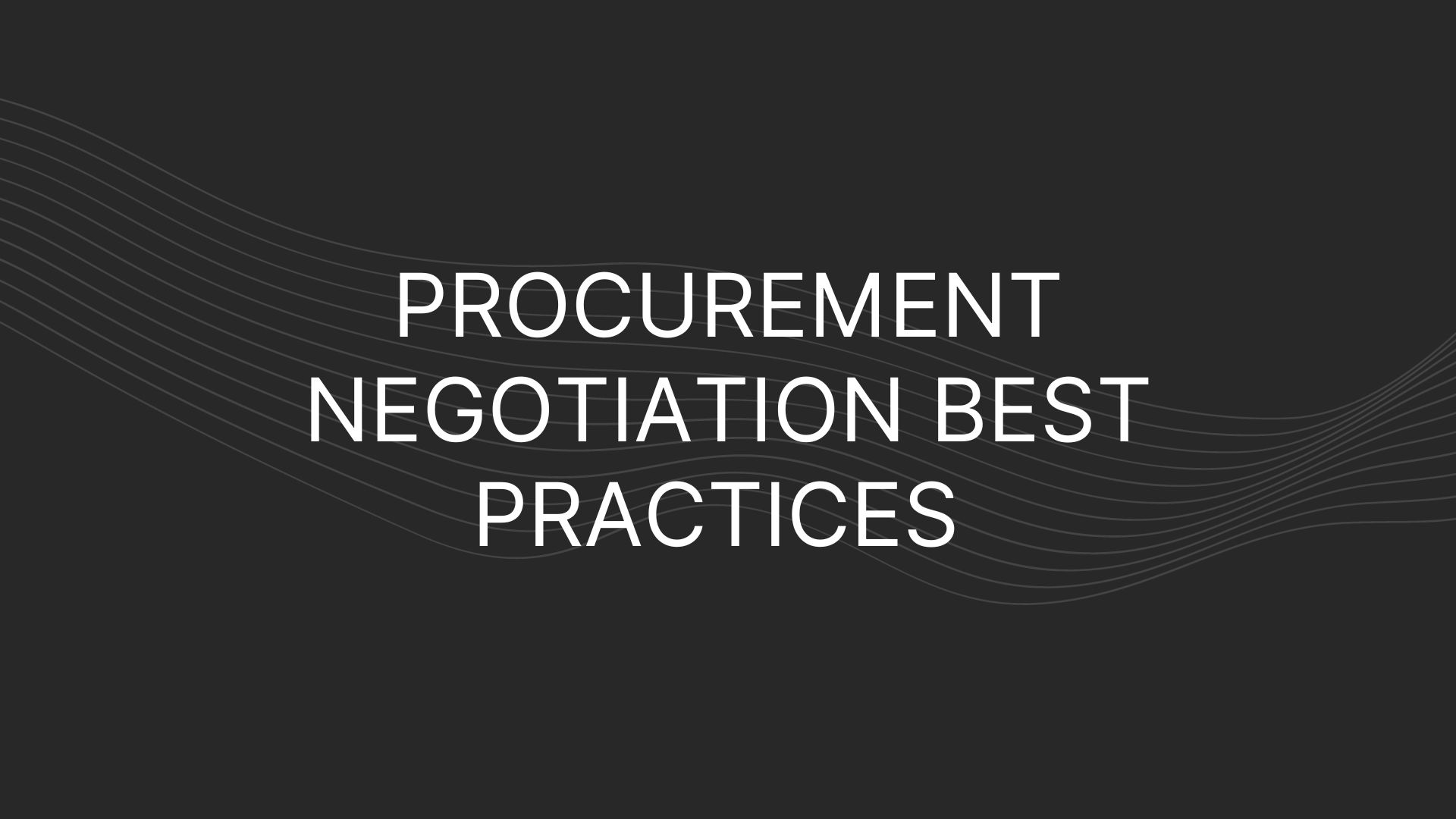Procurement negotiations for software has always been happening but even more-so now. The average company spending on SaaS alone rose drastically in the past seven years. The SaaS industry as a whole grew 5x to a $172 billion industry during this time.
Business owners and stakeholders should use procurement negotiation best practices to save money.
What Is Procurement Negotiation?
Businesses are working tirelessly to:
- Save money
- Maximize efficiency
Procurement negotiation works to do both of these things because it helps lower costs and maximize benefits. During the negotiation process, you’re working to update the terms of expiring contracts or new ones to be more cost-effective for your business.
Why Should Companies Spend Time on Procurement Negotiation?
Negotiations are part of business relationships. When your business has money allocated to software, it’s the responsibility of management to ensure that the:
- Right software is procured
- Prices and terms are the best possible
Spending time on negotiations is crucial to any successful business. The larger your business is, the easier it will be to negotiate because you bring more money to the table. For example, if you have $50,000 to spend on an annual contract, the vendor will be more likely to negotiate with you than a small business with $5,000 to spend.
Executives should:
- Conduct annual procurement negotiations
- Work with multiple vendors to find the best price
- Determine where negotiations may be beneficial
Negotiating in procurement is an art form because you need to leverage the process in your favor while also maintaining positive business ties with vendors.
You also need to consider the repercussions of switching to new software. Software spend has an upfront cost, but there are also collateral costs that you need to consider. All software has a learning curve and a different level of penetration in a business.
A small team of five employees can learn new software quickly and understand how to use it through the company. Large enterprises may have licensing agreements for 5,000 employees, and in this case, you’ll need to consider:
- Implementation costs to install new software in one or multiple offices
- SaaS solutions, which will reduce the IT cost of integration
- Training employees to use the software
- Lost productivity costs involved with switching to new solutions
If you don’t dedicate enough time to procurement negotiations, you may find switching to a new solution has more upfront costs. Allowing enough time for negotiations and research into different solutions is a must for any negotiator.
Businesses should work with vendors to find a happy medium, or a win-win situation, that involves the best price for the business while also being fair for the vendor.
Annual contracts for SaaS are up 500% in the past six years. Most vendors will be more than happy to negotiate on prices or features if you’re willing to sacrifice terms, such as agreeing to a longer-term contract.
Procurement Negotiation Strategies
Procurement negotiation best practices revolve around strategies. You have a lot of negotiating to do, and if you’re not prepared for the process, you won’t get the ideal deal. The following are strategies that can help you make the most out of this process:
Procurement Negotiation Best Practices
You must purchase or renew software that’s within or below budget. Managers who want to impress executives should try and negotiate deals even when a solution is within their budget because it saves money.
A few of the strategies that will make negotiation easier for you include:
New Purchase Strategies
Purchasing new comes as somewhat of a disadvantage because you don’t have a relationship in place. However, you still have negotiating power that can help you save money now and potentially in the future.
- Walk into the negotiation process with a list of other vendors and their prices. You don’t need to show this list to the vendor, but you can use the pricing to your benefit. For example, Company X is willing to offer me X price, can you match this price or do better?
- Ask about the onboarding process. It will cost you money to train team members and get them acclimated to the solution. If onboarding is offered or can be tailored to your business, this should be part of the negotiation process.
- Expect growth. Explain the growth of your business and discuss what this means for your pricing. You may be able to negotiate cheaper prices for licenses, usage and features if you expect the business to grow.
Finally, procurement negotiation best practices consider discussing lifetime discounts. One-time discounts and auto-renewing software may be part of the process. It may be best to negotiate long-term discounts and not to auto-renew software because you’ll be stuck paying for a solution that you may no longer use.
Walk into the negotiation process ready to discuss pricing and be flexible. Most vendors will have the ability to adjust pricing if you’re willing to offer long-term commitments or a minimum number of licenses.
Renewal Strategies
Renewal is another process where you often start out with a disadvantage. Vendors will want to do two things:
- Renew your contract
- Increase prices
Price increases during renewal are the norm, but there are ways to save money here:
- Negotiate growth discounts as the number of licenses or seats increases. For example, you may pay $100 per user per year, but when you hit 1,000 users, the price drops to $90 per year. Vendors will often offer volume discounts because you help bring a lot of revenue into their business.
- Go into the renewal expecting a price increase. Performing due diligence is a must because you need to know how much the vendor increased their pricing. In any given year, around 80% of vendors will have increased their prices. There’s no harm in negotiating the price to stay the same or offer you more value, such as an increase in features.
- Consider alternatives and if you’re willing to change vendors, let it be known
Your strategy is to know during renewal that you’re a valuable client with a growing business. Vendors will expect to negotiate if your business grows because you’re bringing in more money. Go into the negotiation with growth figures. Perhaps you added 50 licenses during the year. Mention this to try and keep prices the same or bring them down.
If you can go with another software vendor’s solution, be sure to mention that a main competitor is offering a better deal.
Sales managers need to make quotas, and if your business brings in substantial revenue, they’re far more likely to cut costs than lose your business to a competitor.
Another thing to consider is timing. End of year and end of quarter can be great times for your software negotiations because sales teams have goals to hit. Even if they’ve already hit their goal, they may be incentivized to beat it because salespeople often get additional bonuses or accelerators for beating their quota.
Negotiation Strategy Tips and Considerations
Every negotiator has their own tactics to turn the discussion in their favor. However, best practices also demand knowing the basics. Procurement negotiators should consider the following:
- Agreement length. Small businesses should negotiate on one-year terms because you may want to move to another solution in the near future unless you’re 100% confident this is a core piece of technology.
- Discounts. If a discount isn’t significant, avoid signing on to long-term contracts because they may not be in your best interest.
- Engage in integrative negotiations. Everyone wants to win in a negotiation. Integrative negotiations make both sides walk away happy. This is a good practice, especially if you plan on staying with the vendor long-term.
- Have a fallback. If the negotiation goes badly, have a fallback solution. Your business needs software to run properly, so always have an alternative option available.
- Listen to the vendor. You and the vendor need each other’s business. Listen to the vendor and try meeting in the middle to find a solution that works for everyone.
- Ask questions. Question the vendor on the product’s roadmap and what they expect to add in the future. You need to know that the solution is going to grow with your needs, too.
Process for Procurement Negotiation
Procurement negotiation typically follows a seven-stage process that starts with prep and ends with closure. These seven stages of negotiation include:
1. Preparation
The first step to any successful negotiation is preparation. In fact, preparation is one of the most important steps. The prep stage is when you and stakeholders iron out the details so that you can enter negotiations armed with knowledge and confidence.
It’s critical you give yourself enough time to prepare for a negotiation. For many annual SaaS renewals, a minimum of 90 days is required to explore alternatives and have a strong understanding of your options.
During this stage, it’s important to clarify:
- Your budget
- The goals and objectives of the product
- What are your non-negotiables
- Any questions that you may have about the product or its function
- The most important factors in choosing the product (aside from budget)
- Any information that will need to be conveyed to the key decision-maker
- The vendor’s product roadmap
- Ask for usage information from the vendor
- Check your contract for auto-renewals and any pre-negotiated terms
- Focus on negotiations that can have a big impact
Also, ensure that you have thoroughly researched the supplier and their product before entering negotiations.
Check your SaaS spend management tool to see if you have duplicate software or licenses that aren’t being used.
2. Opening
Once you’ve completed your prep work, you can move into the opening stage of negotiations. Both parties should make their goals and objectives clear so that there are no surprises. The opening stage can help prevent misunderstandings that could lead to conflict later on.
Keep in mind, the longer you wait, the less leverage you’ll have and fewer options will be available to you.
3. Listening
Active listening is crucial during negotiations. At this stage, both parties should be asking questions and listening carefully to the answers. Listening is a powerful negotiation tool, so make sure that you take full advantage of it.
According to the Institute of Supply Management, skilled negotiators talk two-thirds less than the other party and ask three times as many questions.
By asking questions and actively listening to the supplier’s answers, you can gain valuable knowledge and build leverage by understanding what’s valuable to the supplier. With this information, you can determine where the supplier may be willing to compromise.
4. Proposal
Now that everyone has asked and answered questions, both parties can put forth their proposals. If it’s an in-person meeting, you may request a quick break before making your proposal to regroup and tweak your proposal based on the information you obtained in stage three.
Make sure to get any proposal or new quote with line items of every part of the contract. It’s possible your account executive or account manager has added unnecessary items to your contract.
5. Bargain
If all goes well, negotiations end at stage four. But if both parties do not agree with the proposal, then it’s time to make some compromises.
Refer back to the knowledge you gained during the listening stage, and focus on those areas where you believe the supplier will be willing to compromise.
During this stage, it’s also important for you to be willing to compromise. If you’re not willing to budge on some things, negotiations are less likely to go as planned.
6. Agreement
At this stage, everyone has compromised and come to a proposal that all parties can agree on. It’s important to ensure that this deal is in writing and signed by all parties to make it official. Get a breakdown of everything in the contract. Do not have a single line for the renewal, especially for larger contracts. Make your sales rep show their math.
7. Closing
The closing stage is the final stage. At this point, all parties have access to the written agreement, and things can move forward from here.
Skills Needed for a Successful Procurement Negotiation
You can follow all of the procurement negotiation best practices, but if you don’t have the right skills, you may not succeed with your endeavors. Skilled negotiators have a certain set of skills that gives them an advantage and helps them succeed.
These skills include:
- Active Listening
Active listening skills are invaluable during negotiations. Listening to what the other party has to say and their needs can help you come to a compromise that everyone can agree on. Both parties should feel heard when negotiating, and you need active listening skills to achieve that.
- Patience
Sometimes, negotiations are quick and smooth. But more often than not, the process will take a lot of time and require a lot of patience.
- Integrity
Skilled negotiators are honest, fair and reliable. It is crucial to build a rapport and trust with the other party if you hope to reach an agreement. If a negotiator is unreliable and goes back on their word, the other party may not be willing to move any further with discussions.
- Control of Your Emotions
Depending on the situation, negotiations can be tense and stressful. It is crucial to have emotional control and stay calm even when you’re feeling frustrated. Allowing emotions to take control will make it harder to listen carefully, and the other party may view you as unreliable or unstable.
- Problem-Solving
Negotiations are, after all, all about solving problems. Both parties have issues that need to be resolved, and both sides must find an agreeable solution. Having solid problem-solving skills will help you find ways to compromise while still ensuring that everyone’s needs are met.
Excellent problem-solvers can also think outside of the box to find creative solutions that can move things along more quickly.
- Confidence
A skilled negotiator is confident both in their abilities and their proposals. Confidence can help instill trust, which is crucial to a successful negotiation. If the other party senses a lack of confidence, they may question your proposal and your integrity.
If you lack confidence, practicing your pitch with courage and conviction can help. Preparation and practice can go a long way in helping you feel more self-assured when you step into negotiations.
- Passion
The person doing the negotiation must be passionate. If a person doesn’t have passion, they won’t help the business save money or get the best deal. A few ways that the negotiator can show passion are:
- Learn and understand how the solution helps the business
- Become knowledgeable about the software, features and advancements
- Find fun in negotiating and be willing to change up tactics to see if they work
Some people are born to negotiate. These individuals have traits that make them passionate. That passion can go a long way in helping you find ways to work with the other party to ensure everyone gets what they want. When you have a vested interest in the negotiations, then you’ll find it much easier to compromise on your end and find solutions that work for the other party as well.
How to Negotiate with Procurement to Make it a Win-Win
Procurement negotiations must be a win-win if you plan on working with the vendor long-term. Creating a win-win negotiation requires:
- Both parties to listen to the needs of one another
- Agreeing to compromise to find an amicable solution
- Never forcing either party into unprofitable terms
You need software, and the vendor needs contracts. Both of you are making money decisions. If you can save money and the vendor makes money, it’s a win-win for everyone. If you expect a steep discount or very favorable terms, be willing to offer long-term contract options so that the vendor has guaranteed revenue from the transaction.
Short-term contracts are less valuable to vendors and will leave you with the least amount of negotiating power.
Procurement Negotiation Checklist
- Perform your due diligence to know industry prices and alternatives
- Outline the cost and time to transition to new software
- Create a list of vendors and their pricing
- Ask about the onboarding process and what the vendor can offer you
- Plan on growth and ask for discounts on usage, licenses and features
- Discuss lifetime or long-term discounts because short-term ones are not ideal
- Expect price increases annually and try to negotiate these down
- Avoid long-term agreements if you’re a small business
- Work on coming to a mutually beneficial agreement
- Ask the vendor about the product’s roadmap and future features
- Prepare to bargain and be uncomfortable



